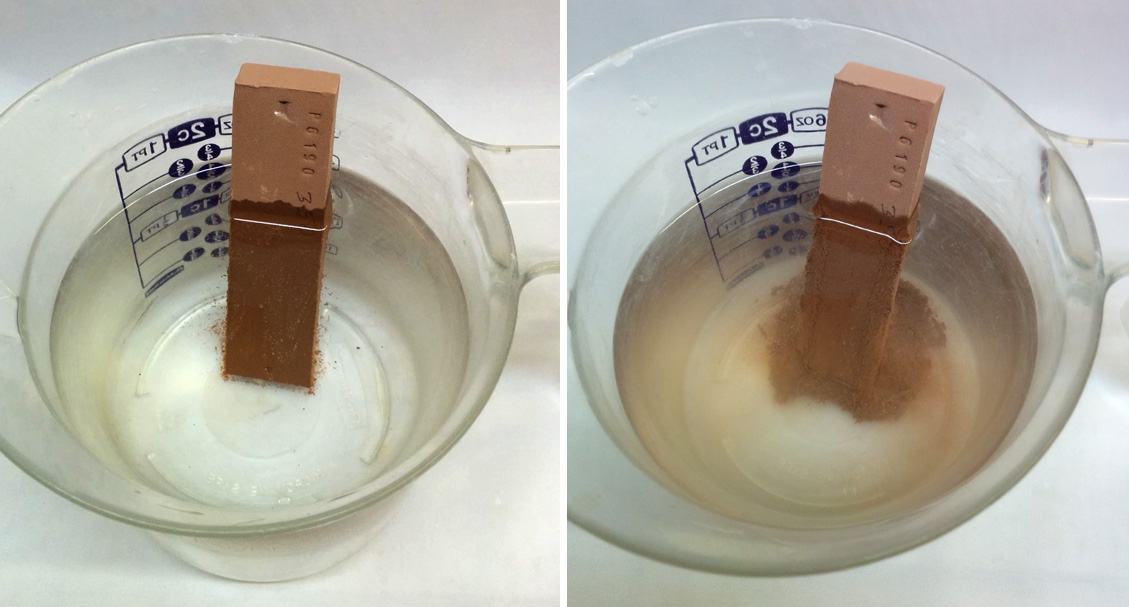| Monthly Tech-Tip | No tracking! No ads! | |
Slaking
This term is using in ceramics to describe how a dry clay disintegrates when it is immersed in or exposed to water. Different clays have different slaking rates.
Key phrases linking here: slaking, slaked, slake - Learn more
Details
'Slaking' refers to the breakdown that normally occurs when thoroughly dried clay chunks or lumps are immersed in water (damp or wet lumps will not normally break down in the same manner because the wet clay resists the penetration of water). Typically the water attacks the surface and particles simply fall away. When slaking is complete a pile of fine material will be found settled on the bottom of the container of water, power mixing will then produce a slurry. The process happens fast enough that the clay is unable to form a membrane to prevent water penetration. A single large lump will even slake if held above the base of the container so that material can fall away freely to the bottom (so the lump is not buried). Clays that slake well will break down in minutes if chunks are less than about 1 cm in size and all have exposure to the water. For some clays it is better to slake the lumps first, then add the finer material later. Slaking works poorly in already-mixed slip, the lumps have to be put into still water and the bucket has to be allowed to sit.
The slaking phenomenon makes it possible to slurry a raw clay mix, even lumps of clay taken right out of the ground, and then screen impurities from the slurry (thus no grinding equipment is needed). Water can be added to enable better mixing or sieving. Then just let it settle for a day or two. If the target is to make a plastic material just remove the water and pour the slurry on to a plaster bat. One way to remove the water from a large heavy bucket of settled clay is to repeatedly touch the flat side of a large absorbent cleaning sponge to the surface and wick up the water.
Slaking can be prevented by adding a hardener to a clay. Xantham gum, corn starch, polymers, sodium silicate are examples. Hardeners are commonly used in earth plaster and when making rocket stoves and cob ovens. Self-hardening clays used in schools also have hardeners added.
Related Information
Slaking. What is that?

This picture has its own page with more detail, click here to see it.
A slaking clay bar (of a typical pottery clay). On the left, the clay bar has been in the water for around 10 seconds. On the right, after a couple of minutes, the rate of slaking has increased dramatically, the corners are disintegrating. Watching this process can be addictive! In about 20 minutes this bar will disappear into a pile on the bottom. Slaking happens most quickly when the sample is completely dry. High plasticity clays take longer (like this one). Slaking can be used to prepare clays for use: Dry the lumps, break them down using a hammer, put them in water, wait (less than 30 minutes for typical pottery plasticity), propeller mix, screen out impurities, then dewater to plastic state.
Links
| Articles |
How to Find and Test Your Own Native Clays
Some of the key tests needed to really understand what a clay is and what it can be used for can be done with inexpensive equipment and simple procedures. These practical tests can give you a better picture than a data sheet full of numbers. |
| Tests |
Ultimate Particle Size Distribution
|
| By Tony Hansen Follow me on        |  |
Got a Question?
Buy me a coffee and we can talk

https://digitalfire.com, All Rights Reserved
Privacy Policy
